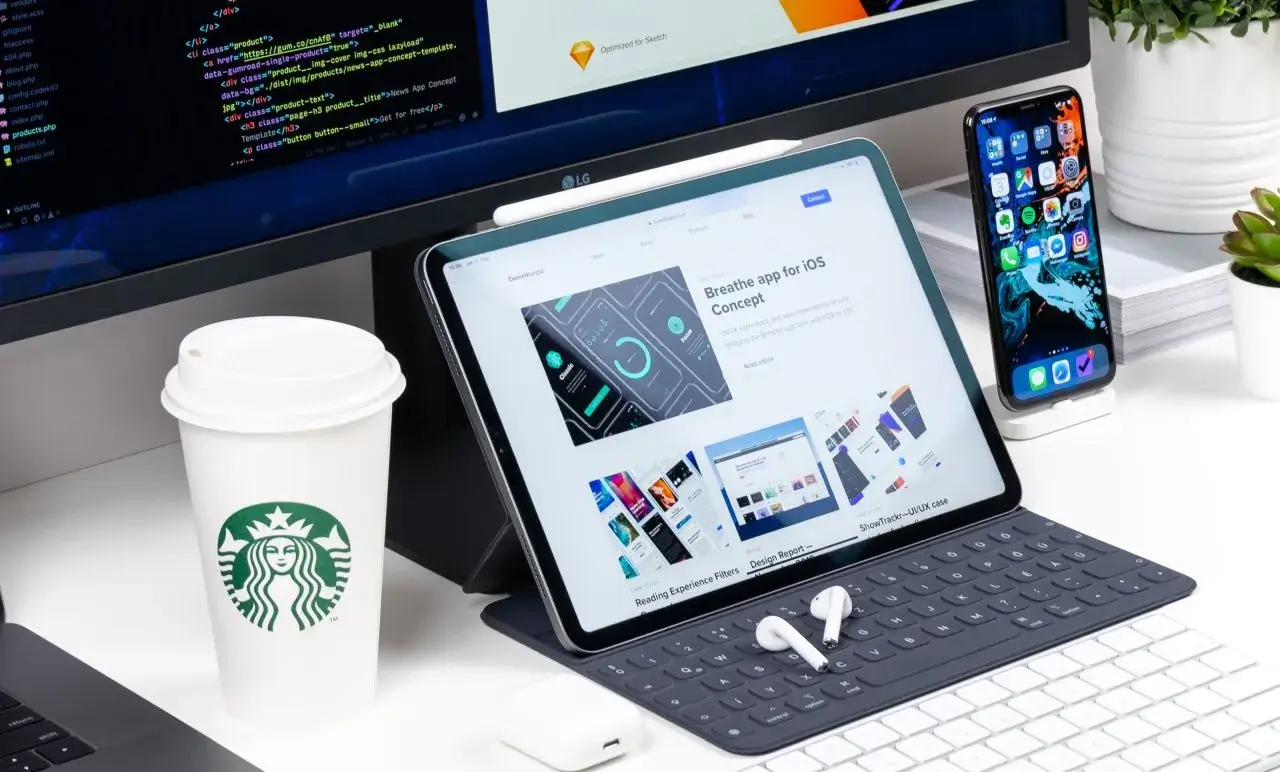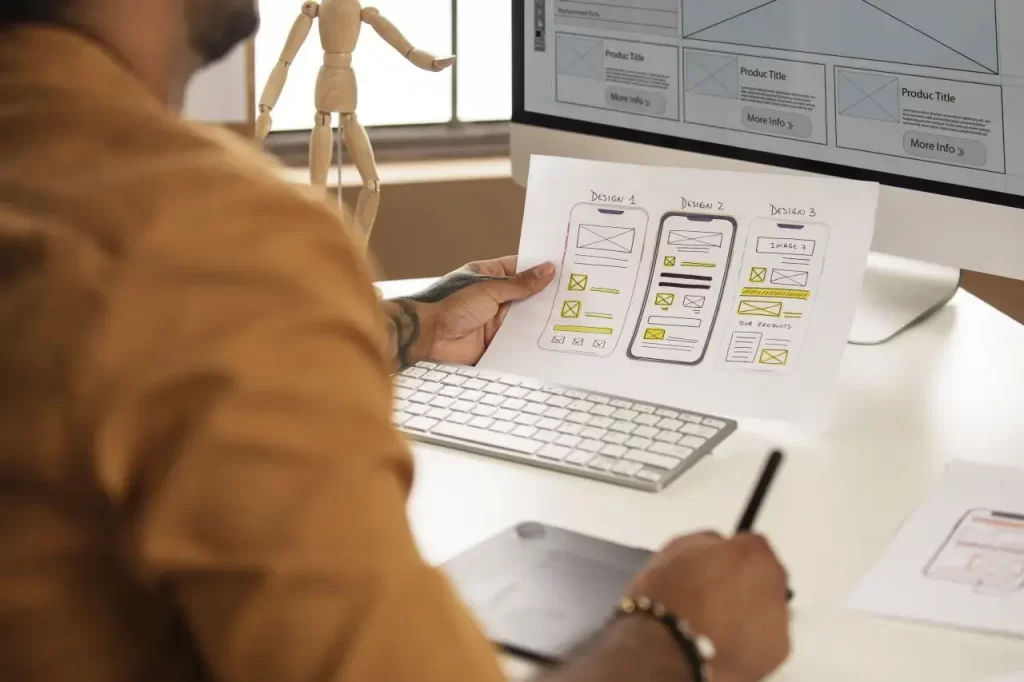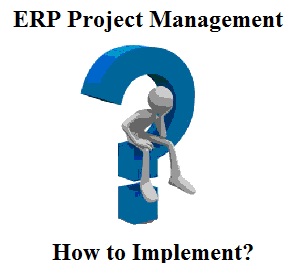Unveiling Mobile Development Costs: What It Takes to Build a Great App MVP

The mobile age is here to stay, so apps are more critical to business success than ever. The average American spends over 5 hours daily on their smartphones, according to data.ai’s recent report. In response to this ever-growing engagement, companies across industries have been creating various mobile applications—from messengers, utilities, and games to eCommerce stores, B2B marketplaces, and news applications.
- But how much does it cost to build a mobile app?
- Is there an average price tag?
- How to make cost calculations?
This blog will guide you through the costs associated with building a mobile application, including technology, team, design, and operational costs. In the end, we’ll recommend ways to reduce those expenses.
Mobile App Costs Examples
MVP Development Cost Breakdown across Popular App Categories
| # | App type | Approx. Cost |
| 1 | Health & Fitness app like MyFitnessPal and Yoga Workout | $20,000-$24,000 |
| 2 | Virtual Marketplace / eCommerce store like letgo and Wish | $28,000-$33,000 |
| 3 | Social / Entertainment app like TikTok and WeChat | $27,000-$31,000 |
| 4 | Crypto wallet like Exodus and Trust Wallet | $19,000-$24,000 |
| 5 | Expense trackers like EveryDollar and Mint | $17,000-$21,000 |
| 6 | Utility apps like ProtonVPN and Wifi Analyzer | $22,000-$26,000 |
| 7 | Travel app like PackPoint and Tripadvisor | $21,000-$29,000 |
Let’s begin with this fundamental question: Why do you need a mobile application?
Why Your Business Needs a Mobile App
Every firm has its unique justification for an app. There are as many reasons to develop a mobile application as businesses.
However, the most common reasons are to bring your company’s product or service closer to users, increase conversion rates, and boost sales.
To make a well-weighted decision, ask yourself the following fundamental questions:
- Does the market for your service or product justify the app development cost?
- Is your target audience likely to use a mobile application for buying your service/product?
- Would an app help your customers more than a website?
- Will a mobile application help you be more competitive in the industry? What does the competition look like?
- Can your company/startup spend considerable time and resources on mobile app development?
- Do you have a technical team in place to complete the app project? If not, who will build it?
If you answer “Yes” to all these questions, you have a solid app development case for your business.
However, if you still have doubts or concerns, think a couple of times and see if you are getting pressured by your competitor or if you have enough resources on your hands. In any case, your decision should refer to facts, not emotions and strong opinions.
Next, let’s talk about the factors of app development costs.
What Does Affect the Mobile App Cost?
Now that you understand if you need a mobile application, let’s see what influences its development cost.
There are three main categories to consider in mobile app cost calculations:
- Technology
- Team
- Operational
Let’s talk about each of the categories in detail.

Factor 1: App Technology
The first category of app dev costs includes development approach and UX/UI design.
Development Approach
There are three concepts in app development:
- native,
- hybrid, and
- cross-platform.
— Native app development
Native apps are usually time and resource-consuming because their development entails using a unique coding language for each OS (XCode and AppCode for iOS and Android Studio and IntelliJ IDEA for Android, for example). As a result, you have to hire dedicated developers for each app project.
However, native mobile development has several advantages:
- Native apps are built entirely with native features and can integrate seamlessly with the OS and system functionality.
- Their performance is very high because they are built from the ground up for a specific OS.
- They can access all the data from the device’s memory and network, so they work faster than hybrid or cross-platform apps.
Bottom line: Consider native development if your team better understands your specific OS’s programming language and if you have sufficient monetary and human resources for this app project.
— Hybrid development
Hybrid apps are hybrid because they use native APIs and third-party libraries. In addition, their code lines are based on open-source software or available free components (Ionic, Apache Cordova, Visual Studio—for instance).
Hybrid apps run on any operating system, but their performance can vary greatly. Consider these benefits:
- They are easiest to develop and integrate with the device’s system and other devices through APIs.
- They run on multiple platforms and have greater reach than native apps.
- They usually don’t require any app installation—they are web applications launched in the device’s browser (thanks to WebView on Android and WKWebView on iOS).
Bottom line: Hybrid apps are an in-between solution for developers who need to build a relatively simple app as quickly as possible without paying premium prices for native development—the best choice for mobile MVPs and startups.
— Cross-platform development
Cross-platform apps are built on code compatible with different mobile platforms, requiring minimal customization to run on two or more different OSes. As a rule, they store data in a remote server or use cloud storage and sync.
The main advantages of this approach are:
- App data is stored in a remote server so that the app is accessible through different devices at all times.
- They are easy to store and deploy on different app stores and platforms.
- The business logic is usually separated from the user interface, so adding new features is more efficient.
- Cross-platform apps are great for eCommerce, messengers, and analysis apps.
Bottom line: Cross-platform development is your best bet to build a multi-functional mobile app with limited resources and budget. However, this solution requires a little more time and attention to detail than the hybrid approach, so it is best for apps that aren’t time-sensitive.
Design Costs
The second technology-related factor affecting app development is design cost. Unfortunately, design costs are difficult to calculate because they depend on an app’s look and feel.
What does it cost to create an app’s UX/UI design? Well, a straightforward way is to check out various similar applications, get in touch with experienced designers at Intersog, and ask them how much they would charge you to create the same or a similar mobile app.
Costs for layout, icons, graphics, sign-up screens, etc., are easy to estimate. However, when it comes to the app’s design and branding, be prepared for a wide range of possibilities.
Stay away from casual smartphone apps and focus on apps with a corporate identity if this approach follows your app’s idea. If you stick to the same style, like, for example, iPhone layouts or Android customizations, your app will look like many other similar ones. On the contrary, if your app looks unique and has an exciting UI design, it will stay in users’ minds and will be more likely to be downloaded.
Designing a mobile app is about staying different and conveying the idea. If you choose a platform-dependent approach for your development, consider using a style and design that sets your app apart.
A word of advice:
- Saving time and money on design is essential if you have a small budget of $10,000-$12,000. An app design is user-friendly and beautiful only if an experienced team does it. Otherwise, leave it to professionals to give your idea the visual form it deserves.
Factor 2. Development Team
The next factor of mobile app cost estimation is the team you’re going to hire.
Will that be in-house app developers? Or an outsourced team? How about hiring freelance developers with Toptal or UpWork?
Here are a couple of things to think about.
- Skills set. First, you check if candidates match your project’s technical requirements. Do they have sufficient mobile development experience? How many apps did they develop in the past few years? What was the complexity of their previous projects? What do they know about security, encryption, and databases?
- Team Size. Knowing how many people will be working on your project is essential. The number of developers and engineers depends on the complexity of the app. However, having at least one lead programmer, 2-3 app developers, 1-2 QA engineers, and a project manager is preferable.
- Experience. Only some developers can build your idea into a mobile app. Before hiring anyone, ensure they have enough experience with similar projects. You also have to check their portfolio and previous work.
- Dedication to deadlines. Hiring developers committed to deadlines is crucial because they can only concentrate if they have project deadlines. Asking them for estimates and deadlines is integral to the hiring process.
Also, consider outsourcing if you are doing a complex app and want to avoid hiring your in-house team. Search B2B rating agencies like Clutch.co and GoodFirms to find developers in Mexico, for example. Look at our rating of nearshore development companies as well.
Factor 3. Operational Costs
This factor is a little different than the others in that it focuses on a company’s ability to provide updates and support, as well as its development process. Keep in mind that the best app in the world is only valid if it reaches users.
People want a mobile app that can be constantly upgraded, so they need to know whether or not the company will be able to handle their requests.
To determine your company’s operational costs, you need to take a look at the following:
- How much it costs to support the app over time?
- How much will it cost to maintain and secure the app?
- How much it costs to keep the app updated and bug-fixed?
- How much it costs to deliver regular updates and get new users?
The answer to these questions is different for every app business. It depends on the app’s usefulness, popularity, and market demand.
Up on all those, you should calculate the money needed for the app’s launch- the so-called GTM (Go-to-market) strategy. The marketing costs are hard to predict, especially regarding mobile apps. However, you can expect to spend a considerable amount of money on app promotion and advertising, as well as brand promotion.
Normally, GTM budgets range from $10K to $100k or more.
Ways to Reduce App Development Expenses
Here are 11 tips that will help you cut down your app development expenses.
- Use a pre-built app. If your app is the same as the competition, consider using a pre-made app from one of the major providers. If you are going to do this, be sure to shop around. You do not want to end up stuck with a crappy app and cannot escape that situation.
- Use a hybrid app platform. You can only use it if you have enough money to hire your team and your app is created with an in-house development process. This won’t be ideal for all apps because it requires more time and resources. However, if it is done well, it can deliver a good app with an excellent user interface and design.
- Hire an experienced development team. As mentioned, using a good developer who knows what they are doing is always the best approach. You don’t want to waste your precious time and money on something that won’t bring a great result. Also, you should ensure your developer has good communication skills and can deliver on time.
- Stick to an MVP approach. If you are trying to save costs, consider a lean app development approach like MVP, which means you will build only the basic functionalities of the app. MVP is a great way to test your app idea cheaply.
- Think about outsourcing. If your app is simple and you have some basic technical knowledge, consider outsourcing work to a developer based in another country. That way, you can get the job done for less money than if you had done it yourself.
- Keep it simple. This applies to the design of your app, but it can also be an essential factor when building your app. If you want less money spent on developing your app, ensure it is simple enough. Creating simple apps is much easier, and it also costs less.
- Get a detailed estimate. When you get an appraisal from a developer, ask for a comprehensive report and all the details about their app development process. This will give you an idea of whether or not the developer is reputable, what their process is and how much money you will have to spend for developing it.
- Outsource a specific feature. If you are on a budget, there’s no need to outsource the whole project. Instead, you can pick one or two critical parts and get help from a developer for that only. This will help you save money.
- Make sure your app is well-designed. A properly designed app will be easier to use, which means fewer support costs and fewer returns. The design also has to look good, which means a better user experience. This can be crucial to your app’s success, so it should be addressed.
- Optimize performance. If your app performs a heavy task, such as complex calculations or rendering large images, you will save money by optimizing its performance. You can also speed up its loading time, improving the user’s experience.
- Use cloud virtualization. Cloud virtualization is a new technology that allows you to create and host all the components of your app in the cloud. This includes the development, testing, and live environments. This can be a much cheaper option because it is not a full-scale software license.
Summary
The entire process of developing and launching an app is complex but also very exciting. It can be a valuable tool for your business and help you to build a stronger brand, generate new customers, and remain competitive. This is why it is imperative to choose the proper development stage. Don’t just select a random outsourcing partner because you need one. Instead, put on your overall technology development competency and get the perfect app for your company.
Also, kind in mind the following:
- App Development Costs: an average app project costs $20-30K. However, any development company telling you that there is a standard mobile application price is probably lying to you. The price depends on the development team’s skill and experience and the product’s complexity. Contact our team to get your quote.
- Quality Assurance: besides the development cost, you will also have to pay for QA. If you go with a nearshore development team based in Mexico or other LATAM countries, the QA costs will be lower than hiring a U.S. company or doing it in-house. On average, you can expect to pay around $35-$45 hourly for a full-time QA engineer from Mexico or Argentina and $50-$60 hourly for an American counterpart.
- Project Management: the project manager’s job is to ensure your project is finished within the established timeframe, on budget, and with all the needed features. To calculate the project manager’s salary in the United States, multiply the time they spend on routine tasks, communication, and meetings by $55 and $70 hourly. This estimate can be lowered by 40-50% if hiring a Mexican project manager with trusted IT companies like Intersog.
A word of advice: don’t underestimate the importance of good project management. It is the cornerstone of successful projects and crucial to keeping your app budget in check. For the same reason, hiring someone from outside is better if you don’t have a PM on your staff.











